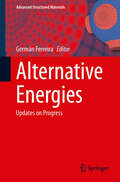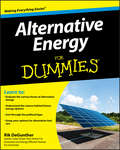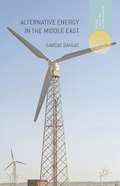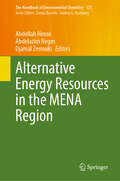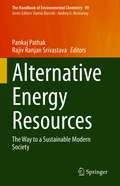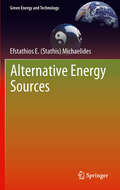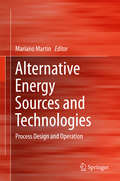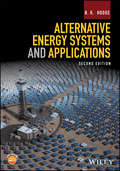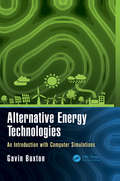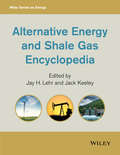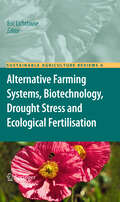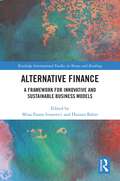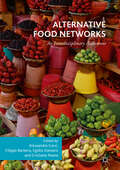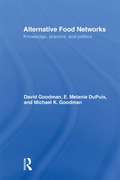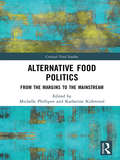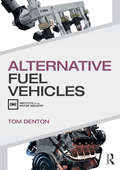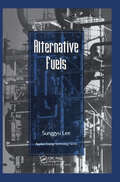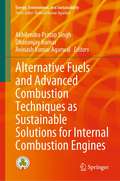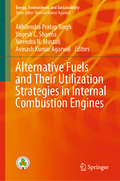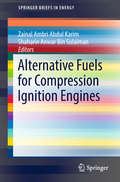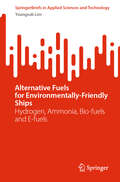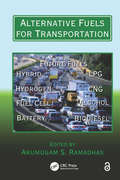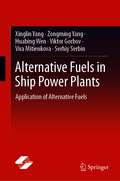- Table View
- List View
Alternative Energies: Updates on Progress (Advanced Structured Materials #34)
by Germán FerreiraThis book presents nine chapters based on fundamental and applied research of alternative energies. At the present time, the challenge is that technology has to come up with solutions that can provide environmentally friendly energy supply options that are able to cover the current world energy demand. Experts around the world are working on these issues for providing new solutions that will break the existing technological barriers. This book aims to address key pillars in the alternative energy field, such as: biomass energy, hydrogen energy, solar energy, wind energy, hydroelectric power, geothermal energy and their environmental implications, with the most updated progress for each pillar. It also includes the life cycle assessment (LCA) and thermoeconomic analysis (TA) as tools for evaluating and optimising environmental and cost subjects. Chapters are organized into fundamental research, applied research and future trends; and written for engineers, academic researches and scientists.
Alternative Energy For Dummies
by Rik DeguntherGet the truth about alternative energy and make it part of your life Want to utilize cleaner, greener types of energy? This plain-English guide clearly explains the popular forms of alternative energy that you can use in your home, your car, and more. Separating myth from fact, this resource explores the current fossil fuel conundrum, the benefits of alternatives, and the energy of the future, such as hydrogen and fuel cell technology. The ABCs of alternative energy - what it is, how it works, and what the real costs are Where we are now - learn where our current energy comes from and how much longer it will last Take the first step - see how energy efficiency and conservation can reduce your reliance on fossil fuels Grasp the alternatives - from nuclear power to geothermal energy to wood burning, understand the benefits that alternative energy can have on the nation Apply alternative fuels to transportation - from biofuels to exotic propulsion to electricity, see how they are best used and how hybrid, all-electric, and fuel cell-powered vehicles work Get a peek into the future - see what the outlook holds for each form of alternative energy discussed Open the book and find: The pros and cons of alternative energy A review of the current world energy economy The problems with fossil fuels, from smog to global warming Advantages of alternative energy Practical results of alternatives you can use in daily life Guidelines for investing in alternative energy vehicles Ten ways you can bring about change right now Insight into the future of energy production - and how you can invest in it
Alternative Energy In The Middle East
by Gawdat BahgatThe Middle East region holds the world's largest oil and natural gas proven reserves. Several Middle Eastern States are major oil producers and consumers. Given price fluctuations and environmental concerns many countries have sought to diversify their energy mix. The Middle East is no exception. Gawdat Bahgat analyzes the geopolitical, economic and strategic forces behind this diversification in the Middle East. He highlights the main advantages and disadvantages of each source of energy.
Alternative Energy Resources in the MENA Region (The Handbook of Environmental Chemistry #131)
by Abdelazim Negm Abdellah Henni Djamal ZerroukiThis book outlines the development of renewable energies in the Middle East and North Africa, it offers up-to-date information about their variability, availability and utilization, and serves as a guide for understanding the MENA renewable energy potential. Readers will find an authoritative discussion about the implementation of renewable energies, trends and forecast of solar, wind and geothermal systems applications in this region. Case studies from China, Mexico and Vietnam are also included in this book to foster the implementation of renewable energies in the MENA region. The MENA region is known for its immense oil, petroleum and gas reserve, being one of the most important regions in the world for fossil energy accessibility and, hence, for the global economic stability. This region holds at the same time the world’s greatest potential for renewable energy and over the past few years it has been receiving national and international political support for promoting the future of solar and wind power energies. However, can the region go green taking into account the availability of the natural resources? Expert contributors from countries such as United Arab Emirates, Egypt, Algeria, Turkey, and Morocco provide their perspective on this challenge and offer a comprehensive overview of the latest pilot projects for renewable energy in the region. This book will appeal to researchers, students, engineers and policymakers interested in the potential of alternative energy resources in the MENA region.
Alternative Energy Resources: The Way to a Sustainable Modern Society (The Handbook of Environmental Chemistry #99)
by Pankaj Pathak Rajiv Ranjan SrivastavaThis book reviews alternative and renewable energy resources in order to pave the way for a more sustainable production in the future. A multi-disciplinary team of authors provides a comprehensive overview of current technologies and future trends, including solar technologies, wind energy, hydropower, microbial electrochemical systems and various biomass sources for biofuel production. In addition, the book focuses on solutions for developing countries. Conventional energy sources are finite, and estimates suggest that they will be exhausted within a few decades. Finding a solution to this problem is a global challenge, and developing countries in particular are still highly dependent on fossil fuels due to their rapidly growing populations accompanied by a huge growth in primary energy consumption. Moreover, the most common conventional energy sources (coal and petroleum) are non-sustainable since their combustion exponentially increases greenhouse gas emissions. As such, there is a pressing need for clean energy based on alternative or renewable resources, not only to ensure energy supplies at an affordable price but also to protect the environment.
Alternative Energy Sources (Green Energy and Technology)
by Efstathios E MichaelidesAlternative Energy Sources is designed to give the reader, a clear view of the role each form of alternative energy may play in supplying the energy needs of the human society in the near future (20-50 years). The two first chapters on "energy demand and supply" and "environmental effects," set the tone as to why alternative energy is essential for the future. The third chapter gives the laws of energy conversion processes, as well as the limitations of converting one energy form to another. The section on exergy gives a quantitative background on the capability/potential of each energy source to produce power. The fourth, fifth and sixth chapters are expositions of fission and fusion nuclear energy, the power plants that may produce power from these sources and the issues that will frame the public debate on nuclear energy. The following five chapters include descriptions of the most common renewable energy sources (wind, solar, geothermal, biomass, hydroelectric) some of the less common sources (e.g. tidal and wave energy). The emphasis of these chapters will be on the global potential of each source, the engineering/technical systems that are used in harnessing the potential of each source, the technological developments that will contribute to wider utilization of the sources and environmental effects associated with their wider use. The last three chapters are: "energy storage," which will become an important issue if renewable energy sources are used widely. The fourteen chapters in the book have been chosen so that one may fit a semester University course around this book. At the end of every chapter, there are 10-20 problems and 1-3 suggestions of semester projects that may be assigned to students for further research.
Alternative Energy Sources and Technologies: Process Design and Operation
by Mariano MartínPresenting a comprehensive analysis of the use of alternative sources of energy and technologies to produce fuels and power, this book describes the energy value chain from harvesting the raw material, (i. e solar, wind, biomass or shale gas) followed by analysis of the processing steps into power, fuels and/or chemicals and finally the distribution of the products. Featuring an examination of the techno-economic processes and integration opportunities which can add value to by-products or promote the use of different sources of energy within the same facility, this book looks at the tools that can make this integration possible as well as utilising a real world case study. The case study of the operation of "El hierro" island is used as an example of the current effort towards more efficient use of the resources available. Tackling head on the open challenges of the supply, the variability of the source and its prediction, the description of novel processes that are being developed and evaluated for their transformation as well as how we can distribute them to the consumer and how we can integrate the new chemicals, fuels and power within the current system and infrastructure, the book takes a process based perspective with such an approach able to help us in the use and integration of these sources of energy and novel technologies.
Alternative Energy Systems and Applications
by B. K. HodgeThe comprehensive guide to engineering alternative and renewable energy systems and applications—updated for the latest trends and technologies This book was designed tohelp engineers develop new solutions for the current energy economy. To that end it provides technical discussions, along with numerous real-world examples of virtually all existing alternative energy sources, applications, systems and system components. All chapters focus on first-order engineering calculations, and consider alternative uses of existing and renewable energy resources. Just as important, the author describes how to apply these concepts to the development of new energy solutions. Since the publication of the critically acclaimed first edition of this book, the alternative, renewable and sustainable energy industries have witnessed significant evolution and growth. Hydraulic fracturing, fossil fuel reserve increases, the increasing popularity of hybrid and all-electric vehicles, and the decreasing cost of solar power already have had a significant impact on energy usage patterns worldwide. Updated and revised to reflect those and other key developments, this new edition features expanded coverage of topics covered in the first edition, as well as entirely new chapters on hydraulic fracturing and fossil fuels, hybrid and all-electric vehicles, and more. Begins with a fascinating look at the changing face of global energy economy Features chapters devoted to virtually all sources of alternative energy and energy systems Offers technical discussions of hydropower, wind, passive solar and solar-thermal, photovoltaics, fuel cells, CHP systems, geothermal, ocean energy, biomass, and nuclear Contains updated chapter review questions, homework problems, and a thoroughly revised solutions manual, available on the companion website While Alternative Energy Systems and Applications, Second Edition is an ideal textbook/reference for advanced undergraduate and graduate level engineering courses in energy-related subjects, it is also an indispensable professional resource for engineers and technicians working in areas related to the development of alternative/renewable energy systems.
Alternative Energy Technologies: An Introduction with Computer Simulations (Nano and Energy #5)
by Gavin BuxtonAlternative energy sources are becoming increasingly important in a world striving for energy independence, clean air, and a reprieve from global warming. Solar cells, wind power, and biofuels are some of the competing alternative energy sources hoping to gain a foothold in our future energy mix, and the economic advantages of these technologies are continually increasing as costs are reduced and efficiencies increased. Alternative Energy Technologies: An Introduction with Computer Simulations explores the science and engineering behind a number of emerging alternative energy technologies, including polymer solar cells, algae biofuels, and artificial leaves. It also addresses the environmental need for these technologies. However, unlike its predecessors, this book employs simple computer models implemented within spreadsheet environments to simulate different aspects of the alternative energy technologies and therefore teach the subject matter. This unique approach: Provides a dual introduction to alternative energy technologies and computer simulation Elucidates the fundamental behaviors and complex interactions within the alternative energy systems Makes computer simulation straightforward and accessible to readers with no prior programming experience Featuring investigative exercises that deepen understanding and inspire further research, Alternative Energy Technologies: An Introduction with Computer Simulations makes an ideal introductory textbook for undergraduate students and a valuable professional reference for experimental researchers.
Alternative Energy and Shale Gas Encyclopedia
by Jay H. LehrA comprehensive depository of all information relating to the scientific and technological aspects of Shale Gas and Alternative Energy Conveniently arranged by energy type including Shale Gas, Wind, Geothermal, Solar, and Hydropower Perfect first-stop reference for any scientist, engineer, or student looking for practical and applied energy information Emphasizes practical applications of existing technologies, from design and maintenance, to operating and troubleshooting of energy systems and equipment Features concise yet complete entries, making it easy for users to find the required information quickly, without the need to search through long articles
Alternative Envelope Components for Energy-Efficient Buildings (Green Energy and Technology)
by Ana-Maria DabijaThis book examines ways of saving energy by using green roofs and facades, solar devices such as building-integrated photovoltaics (BIPV), and thermal solar panels, as components of energy-efficient building envelopes. The author takes an interdisciplinary / multidisciplinary approach to the subject that analyzes several different scientific fields connected to building research—sustainability, sustainable architecture, energy efficiency in buildings, and building envelopes—while approaching other collateral domains, including history, archaeology, botanics, physics, engineering, and landscape architecture. Alternative Envelope Components for Energy-Efficient Buildings will be a welcome resource for researchers, students, and postgraduates in the fields of energy, building materials, and renewable energy, as well as architects, engineers, and specialists in industries related to building products.Looks at the impact of building envelopes on energy usage;Offers readers an introduction to the principles of sustainability;Presents passive and active approaches to using solar devices.
Alternative Farming Systems, Biotechnology, Drought Stress and Ecological Fertilisation (Sustainable Agriculture Reviews #6)
by Eric LichtfouseSustainable agriculture is a rapidly growing field aiming at producing food and energy in a sustainable way for our children. This discipline addresses current issues such as climate change, increasing food and fuel prices, starvation, obesity, water pollution, soil erosion, fertility loss, pest control and biodiversity depletion. Novel solutions are proposed based on integrated knowledge from agronomy, soil science, molecular biology, chemistry, toxicology, ecology, economy, philosophy and social sciences. As actual society issues are now intertwined, sustainable agriculture will bring solutions to build a safer world. This book series analyzes current agricultural issues, and proposes alternative solutions, consequently helping all scientists, decision-makers, professors, farmers and politicians wishing to build safe agriculture, energy and food systems for future generations.
Alternative Finance: A Framework for Innovative and Sustainable Business Models (Routledge International Studies in Money and Banking)
by Mina Fanea-Ivanovici Hasnan BaberThe alternative financing space has grown exponentially in the last few decades, namely as a consequence of the financial crisis, technological advancement, niche customer segments, and more recently the pandemic. Now, with the inclusion of Fintech, online lenders, crowdfunding, accelerators, venture capitalists, or angel investors, this funding channel is no longer seen as a substitute for formal financing, but rather a core one. This book is a comprehensive guide to alternative financing methods, offering insights into emerging trends, the role of FinTech, and the intersection of finance with sustainability, innovation, and entrepreneurship.It fills a knowledge gap by exploring innovative financing channels such as fintech, green finance, and venture capital as well as other non-traditional ways of raising funds, which have become crucial for startups and businesses. It discusses the impact of financial technology (FinTech) on these methods and their function in supporting entrepreneurship and sustainable business, while also examining the implications of these technological advancements in the wider financial sector. It addresses challenges and opportunities for entrepreneurs and explores how alternative financing options can support growth and innovation, particularly in the context of environmentally and socially focused ventures, including how to integrate economic, social, and environmental considerations. The emphasis on sustainability and green finance aligns with the growing global concern for responsible business practices and the Sustainable Development Goals.While the primary audience for the book is scholars, researchers, and students, the inclusion of case studies, and the exploration of various financing options, extends practical cues for policymakers and practitioners and contributes to the understanding of how finance, entrepreneurship, and sustainability intersect in real-world business scenarios.
Alternative Fiscal Rules for Norway
by Daniel Leigh Etibar JafarovA report from the International Monetary Fund.
Alternative Food Networks: An Interdisciplinary Assessment
by Alessandro Corsi Filippo Barbera Egidio Dansero Cristiana PeanoIn recent years, Alternative Food Networks (AFNs) have been a key issue both in the scientific community and in public debates. This is due to their profound implications for rural development, local sustainability, and bio-economics. This edited collection discusses what the main determinants of the participation of operators – both consumers and producers – in AFNs are, what the conditions for their sustainability are, what their social and environmental effects are, and how they are distributed geographically. Further discussions include the effect of AFNs in structuring the food chain and how AFNs can be successfully scaled up.The authors explicitly take an interdisciplinary approach to analyse AFNs from different perspectives, using as an example the Italian region of Piedmont, a particularly interesting case study due to the diffusion of AFNs in the area, as well as due to the fact that it was in this region that the ‘Slow Food’ movement originated.
Alternative Food Networks: Knowledge, Practice, and Politics (Routledge Studies of Gastronomy, Food and Drink)
by David Goodman Michael K. Goodman E. Melanie DuPuisFarmers’ markets, veggie boxes, local foods, organic products and Fair Trade goods – how have these once novel, "alternative" foods, and the people and networks supporting them, become increasingly familiar features of everyday consumption? Are the visions of "alternative worlds" built on ethics of sustainability, social justice, animal welfare and the aesthetic values of local food cultures and traditional crafts still credible now that these foods crowd supermarket shelves and other "mainstream" shopping outlets? This timely book provides a critical review of the growth of alternative food networks and their struggle to defend their ethical and aesthetic values against the standardizing pressures of the corporate mainstream with its "placeless and nameless" global supply networks. It explores how these alternative movements are "making a difference" and their possible role as fears of global climate change and food insecurity intensify. It assesses the different experiences of these networks in three major arenas of food activism and politics: Britain and Western Europe, the United States, and the global Fair Trade economy. This comparative perspective runs throughout the book to fully explore the progressive erosion of the interface between alternative and mainstream food provisioning. As the era of "cheap food" draws to a close, analysis of the limitations of market-based social change and the future of alternative food economies and localist food politics place this book at the cutting-edge of the field. The book is thoroughly informed by contemporary social theory and interdisciplinary social scientific scholarship, formulates an integrative social practice framework to understand alternative food production-consumption, and offers a unique geographical reach in its case studies.
Alternative Food Politics: From the Margins to the Mainstream (Critical Food Studies)
by Michelle Phillipov Katherine KirkwoodMedia interest in food has intensified in recent years, leading to a contemporary food landscape where ‘alternative’ food practices are increasingly visible. Concerns that were once exclusively the domain of activist movements motivated by environmental, animal rights, health and anti-corporate agendas are now central to primetime television cooking shows, mobile apps and social media. This book is the first to explore the impact of popular media and culture on contemporary food politics. Through examination of a range of media and cultural texts, including news, digital media, advertising and food labelling, it brings together leading and emerging scholars in food studies, media and communications, sociology, law, policy studies, business, and geography. The book explores the practices of alternative food movements, the marketing techniques of conventional and alternative food producers, and the relationships between food industries, media, and the public. Covering topics ranging from agtech start-ups and social justice projects, to new ways of mediating food waste, celebrity, and ‘ethical’ foods, Alternative Food Politics reveals the importance of media as a driver of food system transformation. This is a pivotal time for media and food industries, and this book is essential reading for scholars and students seeking to better understand the futures, possibilities and limits of food politics today.
Alternative Fuel Vehicles
by Tom DentonAlternative Fuel Vehicles gives full coverage of all associated qualifications and awards in the emerging field of alternative fuels. It is an essential introduction to the ever-growing demand for vehicles that operate using non-conventional fuels. This first book on AFVs endorsed by the IMI begins with an overview of the subject, ideal for beginners, before outlining what is meant by alternative fuels, why they are necessary, and why climate change and associated legislation are key drivers. Details of how alternative fuels are made, the supply infrastructure, and how these vehicles work are all included. A chapter on fuel cells introduces learners to the use of hydrogen, and one on engines and engine management includes coverage of combustion as an aid to understanding why changing the type of engine fuel is complex. Some basic engine technology is included to help readers new to the subject. Real-life case studies and examples are used to illustrate different technologies in current use, and to speculate on new developments. This book is an ideal companion to any unit of study on alternative fuel, but will also be of interest to working technicians and keen amateurs.
Alternative Fuels (Green Chemistry And Chemical Engineering Ser.)
by Sunggyu LeeEnvironmentally acceptable alternative fuels are in demand. This book dicusses the energy resources that are directly tied to the alleviation of petroleum dependence, and the science and technology in the area of alternative fuels. Various process treatments leading to cleaner and better use of existing fuel resources are discussed. This comprehensive reference book is consistent and is helpful for students and researchers.
Alternative Fuels and Advanced Combustion Techniques as Sustainable Solutions for Internal Combustion Engines (Energy, Environment, and Sustainability)
by Avinash Kumar Agarwal Akhilendra Pratap Singh Dhananjay KumarThis monograph covers different aspects related to utilization of alternative fuels in internal combustion (IC) engines with a focus on biodiesel, dimethyl ether, alcohols, biogas, etc. The focal point of this book is to present engine combustion, performance and emission characteristics of IC engines fueled by these alternative fuels. A section of this book also covers the potential strategies of utilization of these alternative fuels in an energy efficient manner to reduce the harmful pollutants emitted from IC engines. It presents the comparative analysis of different alternative fuels in a variety of engines to show the appropriate alternative fuel for specific types of engines. This book will prove useful for both researchers as well as energy experts and policy makers.
Alternative Fuels and Their Utilization Strategies in Internal Combustion Engines (Energy, Environment, and Sustainability)
by Yogesh C. Sharma Avinash Kumar Agarwal Akhilendra Pratap Singh Nirendra N. MustafiThis book covers alternative fuels and their utilization strategies in internal combustion engines. The main objective of this book is to provide a comprehensive overview of the recent advances in the production and utilization aspects of different types of liquid and gaseous alternative fuels. In the last few years, methanol and DME have gained significant attention of the energy sector, because of their capability to be utilized in different types of engines. This book will be a valuable resource for researchers and practicing engineers alike.
Alternative Fuels for Compression Ignition Engines (SpringerBriefs in Energy)
by Zainal Ambri Abdul Karim Shaharin Anwar Bin SulaimanThis book examines the development and utilization of alternative fuels in order to reduce or control the environmental impact of internal combustion engine exhaust gases. Discussing alternative fuels such as dual fuel techniques, rubber seed/palm oil biodiesel, syngas dual-fuelling, water-in-diesel emulsions and gasification of date palm seeds, it is a valuable resource for researchers in the field of engine development and on alternative fuels.
Alternative Fuels for Environmentally-Friendly Ships: Hydrogen, Ammonia, Bio-fuels and E-fuels (SpringerBriefs in Applied Sciences and Technology)
by Youngsub LimThis book reports on current shipping and shipbuilding industries' efforts for decarbonization. It demonstrates what regulations have been made for large ships on international voyages and points to what is to change in the future. The book also quantitatively reviews the current challenges of alternative fuels such as hydrogen, ammonia, biofuels, and e-fuels, considering economics, safety, and greenhouse gas emissions assessments.
Alternative Fuels for Transportation
by Arumugam S. RamadhasExploring how to counteract the world's energy insecurity and environmental pollution, this volume covers the production methods, properties, storage, engine tests, system modification, transportation and distribution, economics, safety aspects, applications, and material compatibility of alternative fuels. The esteemed editor highlights the importance of moving toward alternative fuels and the problems and environmental impact of depending on petroleum products. Each self-contained chapter focuses on a particular fuel source, including vegetable oils, biodiesel, methanol, ethanol, dimethyl ether, liquefied petroleum gas, natural gas, hydrogen, electric, fuel cells, and fuel from nonfood crops.
Alternative Fuels in Ship Power Plants: Application of Alternative Fuels
by Zongming Yang Huabing Wen Xinglin Yang Viktor Gorbov Vira Mitienkova Serhiy SerbinThis book describes the feasibility and status of the use of alternative fuels in marine engineering, as well as the application of liquefied natural gas, biodiesel and their blends as marine fuels, and the combustion of synthetic coal-based fuels.Each chapter in the book ends with a summary, which gives the reader a quick and clear understanding of the main contents of the chapter. The book gives a lot of advice on the selection of equipment and parameters, fuel reserves and preparation for scholars related to alternative fuels in ships, and points them in the way. It contains lots of illustrations and tables and explains it in the form of chart comparison. The authors have developed mathematical models and methods for calculating the parameters of fuel systems for biodiesel fuels and liquefied natural gas. Recommendations for choosing the rational parameters of these systems are given, as are schematic solutions of the fuel systems, recommendations for selecting equipment, storing, and preparing the fuels. Application of the materials described in the book provides the SPP designers with a reliable tool for choosing rational characteristics of the fuel systems operating on alternative fuels and improving the efficiency of their application on ships.
